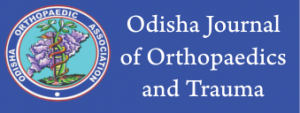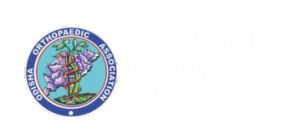Comparison of the Outcomes of Intra-articular Distal Femur Fracture Managed With Distal Femoral Nail and Locking Compression Plate: A Prospective Study
Vol 02 | Januar 2021 | page: 12-15 | Manoranjan Mallick, Gopal Chandra Sethi, Abinash Ray, Debi Prasad Nanda
DOI- https://doi.org/10.13107/ojot.2020.v42i01.018
Authors: Manoranjan Mallick [1], Gopal Chandra Sethi [1], Abinash Ray [1], Debi Prasad Nanda [1]
[1] Department of Orthopaedics, SCB Medical College, Cuttack, Odisha, India.
Address of Correspondence
Dr. Debi Prasad Nanda,
SCB Medical College, Cuttack, Odisha, India.
E-mail: drdebiortho@gmail.com
Abstract
Background: The treatment of intraarticular distal femur fracture still remains a debatable issue. The need for anatomical reduction and maintenance of the joint congruity while giving the patient a painless mobile knee is quite challenging. There is little Indian literature evidence comparing the functional outcome after treatment with distal femoral nail and locking compression plate in these group pf fractures. We decide to clear this gap in knowledge by this current study.
Material and methods: This was a prospective study Of 20 patients with closed intra-articular distal femoral fracture treated either with distal femoral nail and locking compression plate. It was carried out in the Department of Orthopaedics, SCB Medical College, and Cuttack during the period of August 2017 to November 2019 and functional results are analysed with 100 point scores by Neer et al i.e. Neer’s criteria.
Result: Average healing time was better in the case of nailing (15.2 weeks) than plating (18 weeks) which was assessed both clinically and radiologically. The average knee flexion range of motion was better in the case of nailing (112°)than plating (93°). With Neer’s score, an Excellent result was obtained in 90% cases in nailing comparing to only 30% with plating where a fair and poor result was obtained in 10% cases in nailing comparing to 70% with plating.
Conclusion: In the present study, retrograde nailing was found to be a better fixation system for both extra as well as intra-articular fractures(type C1 & type C2) of distal femur with better outcome in terms of range of movements, early mobilization, union and less operative time and blood loss.
Keywords: Intra-Articular Fractures; Bone Plates; Range of Motion; Articular.
References
1. Arneson TJ, Melton LJ 3rd, Lewallen DG, et al. Epidemiology of diaphyseal and distal femoral fractures in Rochester, Minnesota, 1965-1984. Clin orthop.1988;234:188-94.
2. Schandelmaier P, Partenheimer A, Koenemann B, et al. Distal femoral fractures and LISS stabilization. Injury 2001; 32 Suppl 3:SC55-63.
3. Gurkan V, Orhun H, Doganay M, Salioğlu F, Ercan T, Dursun M, et al. Retrograde intramedullary interlocking nailing in fractures of the distal femur. Acta Orthop Traumatol Turc. 2009; 43:199-205.
4. Smith WR, Ziran BH, Anglen JO, Stahel PF. Locking plates: tips and tricks. J Bone Joint Surg Am. 2007; 89(10):2298-307.
5. Markmiller M, Konrad G, Südkamp N: Femur-LISS and distal femoral nail for fixation of distal femoral fractures: are there differences in outcome and complications? Clin Orthop Relat Res. 2004; 426:252-257.
6. Lujan TJ, Henderson CE, Madley SM, Fitzpatrick DC, Marsh JL, Bottlang M. Locked plating of distal femur fractures leads to inconsistent and asymmetric callus formation. J Orthop Trauma. 2010; 24:156-62.
7. Herrera DA, Kregor PH, Cole PA, Levy B, Jonsson A, Zlowodzki M. Treatment of acute distal femur fractures above a total knee arthroplasty: Systematic review of 415 cases (1981-2006) Acta Orthopaedics. 2008; 79(1):22-27
8. Gao K, Gao W, Huang J, Li H, Li F, Tao J, Et Al. Retrograde Nailing Versus Locked Plating Of Extra-Articular Distal Femoral Fractures: Comparison Of 36 Cases. Med Princ Pract. 2013; 22:161-66.
9. Neer II CS, Grantham SA, Shelton ML. Supracondylar Fracture of the Adult Femur. The Journal of Bone & Joint Surgery. 1967; 49A:591-613.
10. Henderson CE, Lujan TJ, Kuhl LL, Bottlang M, Fitzpatrick DC, Marsh JL. Healing Complications Are Common After Locked Plating for Distal Femur Fractures. ClinOrthopRelat Res 2011 June; 469(6): 1757-1765
11. Markmiller M, Konrad G, Sudkamp N. Femur-LISS and distal femoral nail for fixation of distal femoral fractures: are there differences in outcome and complications? ClinOrthopRelat Res. 2004; (426):252-257
12. Kumar A, Jasani VM Butt MS. Management of distal femoral fractures in elderly patients using retrograde titanium supracondylar nails. Injury, 31(3): 169-73, Apr 2000
13. Ingman AM. Retrograde intramedullary nailing of supracondylar femoral fractures: Design & Development of a New Implant. Injury, 33(8); 707-12: Oct 2002
14. Leggon RE, Feldmann DD. Retrograde Femoral Nailing: A Focus On The Knee. Am J Knee Surg. 2001; 14:109-118.
15. Hoskins W, Sheehy R, Edwards ER, Hau RC, Bucknill A, Parsons N, Griffin XL. Nails or plates for fracture of the distal femur? Bone Joint J. 2016; 98-B:846-50.
| How to Cite this Article: Mallick M, Sethi GC, Ray A, Nanda D| Comparison of the Outcomes of Intra-articular Distal Femur Fracture Managed With Distal Femoral Nail and Locking Compression Plate: A Prospective Study | Odisha Journal of Orthopaedics and Trauma | January 2021; 02: 12-15. https://doi.org/10.13107/ojot.2020.v42i01.018 |
(Abstract Text HTML) (Download PDF)


